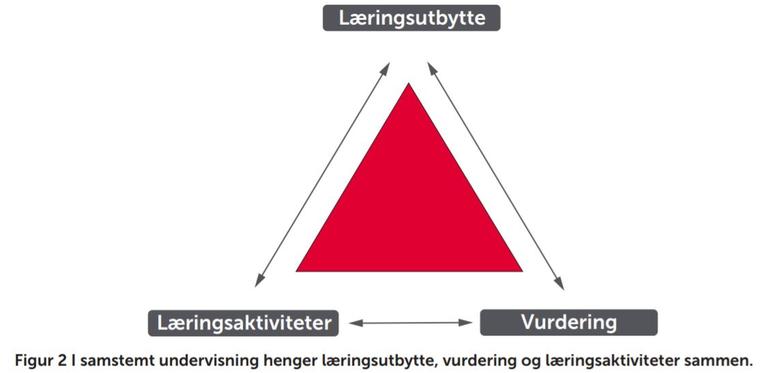
Constructive alignment: when everything is integrated
After completing a course in higher education, students are assessed as to whether they have achieved the learning outcomes set out in the relevant curricula and course plans. Learning outcomes will consist of knowledge, skills and general competence, and their teacher must organise his/her course plan to ensure that all students have the opportunity to achieve the outcomes. This means providing the students with both theoretical knowledge and practical skills.
When the learning outcomes, assessment process and learning activities are well integrated, we can say that we have achieved constructive alignment. This means that we have advanced from a linear, content-based understanding of the teaching process to a holistic approach in which all the component elements mutually influence each other.
Linear approach:
- What subjects am I teaching?
- What teaching methods am I using?
- How do I assess my students to check that they have learned what I have been teaching them?
An integrated approach – constructive alignment:
- How do I offer learning activities that help my students achieve their goals?
- What competencies do I want my students to have after my teaching that they didn’t have before, and to what levels?
- How do I assess my students to find out the extent to which learning outcomes have been achieved?
Constructive alignment is commonly visualised using a triangular diagram illustrating how each of the three components are linked together, and that each is as important as the others.

Source: FUN (2017), Kvalitet i nettundervisning - en veileder (Guidelines for quality assurance in online teaching).
The following video, produced by Svend Andreas Horgen (eDU), provides an excellent summary of the relationship between learning outcomes, learning activities and student assessment, and offers tips about how to succeed with a coherent teaching approach:
What pedagogical approach is appropriate to your subject?
When you are planning changes in a subject, it is important to think carefully about how you intend to approach the teaching process – your pedagogical approach.
- Are you aware of any learning challenges that your students may have?
- Are there any specific learning challenges that you are well aware of?
- What do you have to do to motivate your students to apply themselves when it comes to learning?
- As their teacher, what role do you want to play?
- What will you be requiring of your students?
- Is collaborative learning important in your subject?
- How do you achieve deep learning?
- Is there anything in particular in the nature of your subject that indicates how the learning process should be organised?
It is common to teach using traditional lecturing, but it is important to ask yourself whether this is appropriate to the challenges inherent in your subject. It may be possible for you to opt for an entirely different approach, perhaps by combining lectures with other methods at given periods during the course.
Synchronous and asynchronous teaching; what happens and when?
Regardless of whether you are teaching online or on campus, you have to decide what your students will be learning synchronously in class and asynchronously between classes.
- Do you want to devote the time you spend teaching to lectures, activities or a mixture of the two?
- Shall the students solve problems and work with the subject material outside the classroom?
If you intend to combine the asynchronous use of digital resources with physical teaching (or synchronous teaching using Zoom), we can call this ‘blended teaching’. In practice, it is perfectly possible to make digital content resources and/or learning activities available to your students both prior to and after a face-to-face classroom session. Examples may include video clips that can be viewed in advance or summary texts that can be distributed after class; activities in discussion fora that promote experience exchange and a sharing culture; or exercises that can be peer-reviewed by the students themselves.
Canvas makes it easy to build modules with asynchronous content of this type, and such modules may serve to provide support throughout the course in connection with both online and campus-based studies.
Using your course plan as a tool
The main function of the course plan is to act as a contract between USN, the students and working life. However, we can also envisage a situation in which the course plan can be used during different phases of the teaching process.
A brief summary:
- The course plan can serve as an active document (tool) throughout the teaching of the course.
- As a teacher, you will use the course plan to plan your teaching and ensure that learning activities and student assessment are linked to your students’ learning outcomes.
- The course plan helps your students to understand why the course elements are what they are. It will help them to understand the learning outcomes and focus their efforts on the right goals.
Resources
- Biggs, J., & Tang, C. (2010, February). Applying constructive alignment to outcomes-based teaching and learning. In Training material for “quality teaching for learning in higher education” workshop for master trainers, Ministry of Higher Education, Kuala Lumpur (pp. 23-25).
- Biggs, J. B., & Tang, C. S. K. (2011). Teaching for quality learning at university. The Society for Research into Higher Education. 4th edition. (1st edition 1999)
- Brabrand, C. (2006), Teaching teaching and understanding understanding. En video om Susan og Robert.
- Prøitz, T. Hva kan økt fokus på læringsutbytte bety for planlegging og gjennomføring av undervisning? Et foredrag for UH-ped-nettverket. (Click on 'open in browser', then the 'Play'-button)